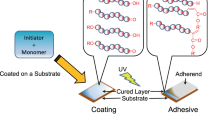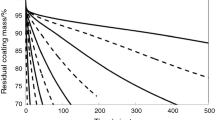Abstract
The mechanism of oxidative stabilization of acrylic fibres is characterized by two limiting cases which are determined by the fibre chemistry, the reaction conditions, and the diameter of the filament. These limiting cases correspond to diffusion-limited and reaction-limited kinetic processes. Although the chemistry of stabilization is too complex to specify, the various reactions are separated into two categories: those which occur prior to or concurrently with polymerization of the nitrile groups, called “prefatory reactions”; and those which occur subsequent to nitrile polymerization, called “sequent reactions”. Under conditions which allow the prefatory reactions to occur significantly before the sequent reactions, the diffusion of oxygen to reactive sites is limited by previously oxidized material; and the fibre shows a typical two-zone morphology. Under conditions where the prefatory and sequent reactions occur sequentially, the overall stabilization process is limited by the rate of the prefatory reactions; but a skin is established at the fibre surface which acts as an oxygen barrier. Data from a variety of sources, including oxygen analysis, microscopic examination, fibre residue after etching, tension developed in fibres held at constant length, and small-angle X-ray patterns, are cited as evidence for the two limiting cases.
Similar content being viewed by others
References
N. Grassie andR. McGuchan,Europ. Polymer J. 6 (1970) 1277.
Idem, ibid. 7 (1971) 1091.
Idem, ibid. 7 (1971) 1357.
Idem, ibid. 7 (1971) 1053.
Idem, ibid. 8 (1972) 243.
Idem, ibid. 8 (1972) 257.
Idem, ibid. 8 (1972) 865.
Idem, ibid. 9 (1973) 113.
Idem, ibid. 9 (1973) 507.
J. W. Johnson, W. Potter, P. G. Rose andG. Scott,Brit. Polymer J. 4 (1972) 527.
E. Fitzer andD. J. Muller,ACS Polymer Preprints 14 (1973) 397.
Idem, Makromol. Chem. 144 (1971) 117.
O. P. Bahl andL. M. Manocha,Agnew. Makromol. Chem. 48 (1975) 145.
D. J. Muller, E. Fitzer andA. K. Fiedler, Proceedings of the International Carbon Fibres Conference (Plastics Institute, London, 1971) p. 10.
W. Watt andW. Johnson,Appl. Polymer Symp. 9 (1969) 215.
N. Grassie andJ. N. Hay,J. Polymer Sci. 56 (1962) 189.
A. J. Clarke andJ. E. Bialey,Nature 243 (1973) 146.
S. I. Stupp andS. H. Carr,J. Polymer Sci., Polymer Phys. Ed. 15 (1977) 485.
B. Danner andJ. Meybeck, Proceedings of the International Carbon Fibres Conference (Plastics Institute, London, 1971) p. 36.
K. Miyamichi, M. Okamoto, O. Ishizuka andM. Katayama,Sen-i Gakkaishi 22 (1969) 538 (translation available from Royal Aircraft Establishment, UK).
W. Watt andJ. Green, Proceedings of the International Carbon Fibres Conference (Plastics Institute London, 1971) p. 23.
W. Watt andW. Johnson,Nature 257 (1975) 210.
R. H. Knibbs,J. Microscopy 94 (1971) 273.
P. J. Goodhew, A. J. Clarke andJ. E. Bailey,Mater. Sci. Eng. 17 (1975) 3.
L. H. Peebles Jr. Encyclopedia of Polymer Science and Technology”, Supplementary Vol. 1 (Wiley, New York, 1976) p. 1.
W. Watt andW. Johnson, Proceedings of the 3rd Conference on Industrial Carbon and Graphite (Society of Chemical Industry, London, 1970) p. 417.
G. Love, M. G. Cox andV. D. Scott,Mater. Res. Bull. 10 (1975) 815.
S. B. Warner, Sc.D. Thesis, MIT (1976).
G. Hinrichsen,J. Appl. Polymer Sci. 17 (1973) 3305.
J. Crank, “Mathematics of Diffusion” (Oxford University Press, 1956) Ch. 7.
S. Allen, Ph.D. Thesis, North Carolina State University (1975).
J. P. Craig, J. P. Knudsen andV. F. Holland,Text. Res. J. 32 (1962) 435.
J. H. Dumbleton andJ. Bell,J. Appl. Polymer Sci. 14 (1970) 2402.
S. B. Warner, L. H. Peebles Jr andD. R. Uhlmann,J. Mater. Sci. 14 (1979) in press.
M. E. Fillery andP. J. Goodhew,Nature Phys. Sci. 233 (1971) 118.
C. N. Tyson,ibid. 229 (1971) 121.
S. B. Warner, L. H. Peebles Jr andD. R. Uhlmann,J. Mater. Sci. 14 (1979) 565.
Author information
Authors and Affiliations
Additional information
Based in part on a thesis submitted by SBW in partial fulfilment of the requirements for the Sc.D. degree in materials engineering, MIT, 1976;
Rights and permissions
About this article
Cite this article
Warner, S.B., Peebles, L.H. & Uhlmann, D.R. Oxidative stabilization of acrylic fibres. J Mater Sci 14, 556–564 (1979). https://doi.org/10.1007/BF00772714
Received:
Accepted:
Issue Date:
DOI: https://doi.org/10.1007/BF00772714




